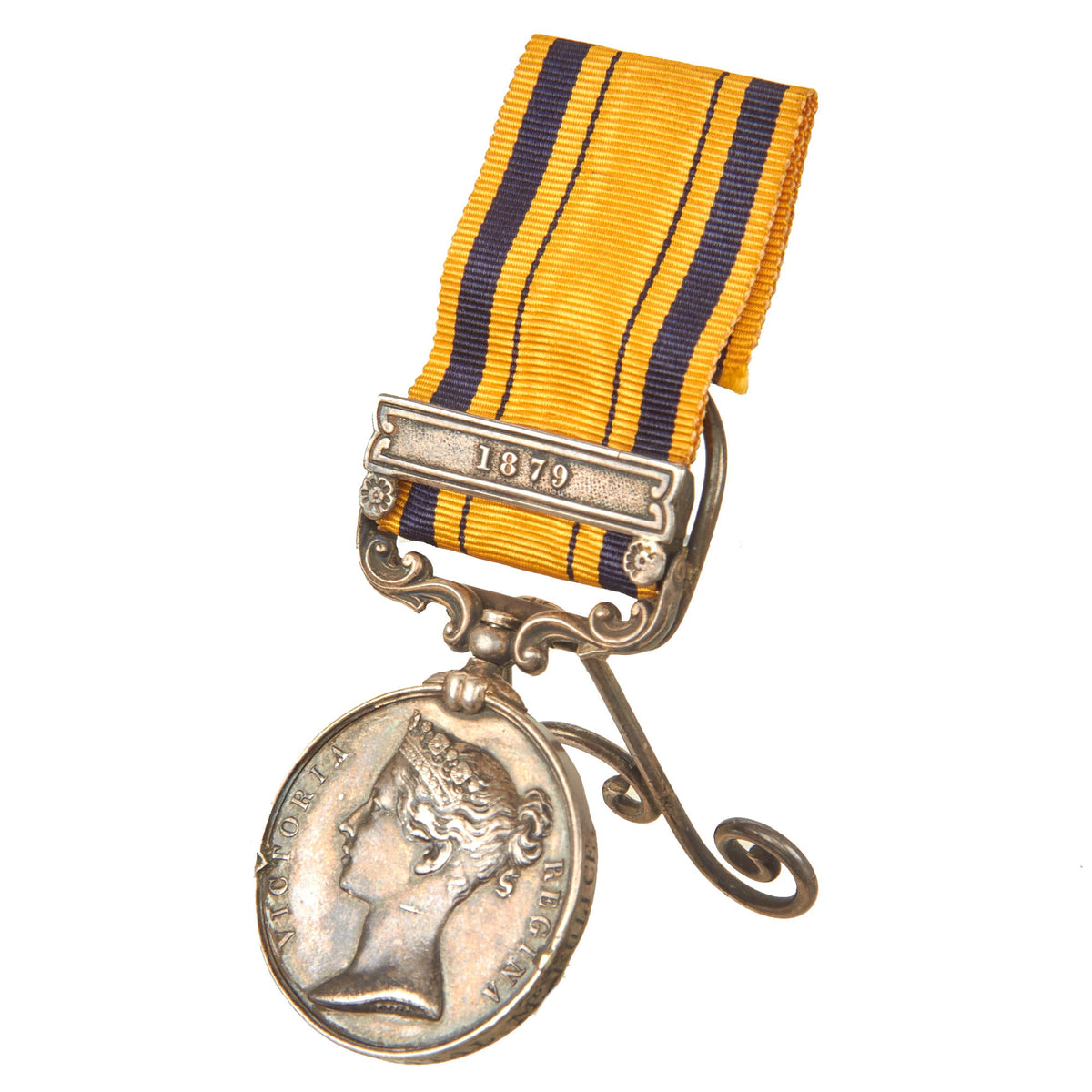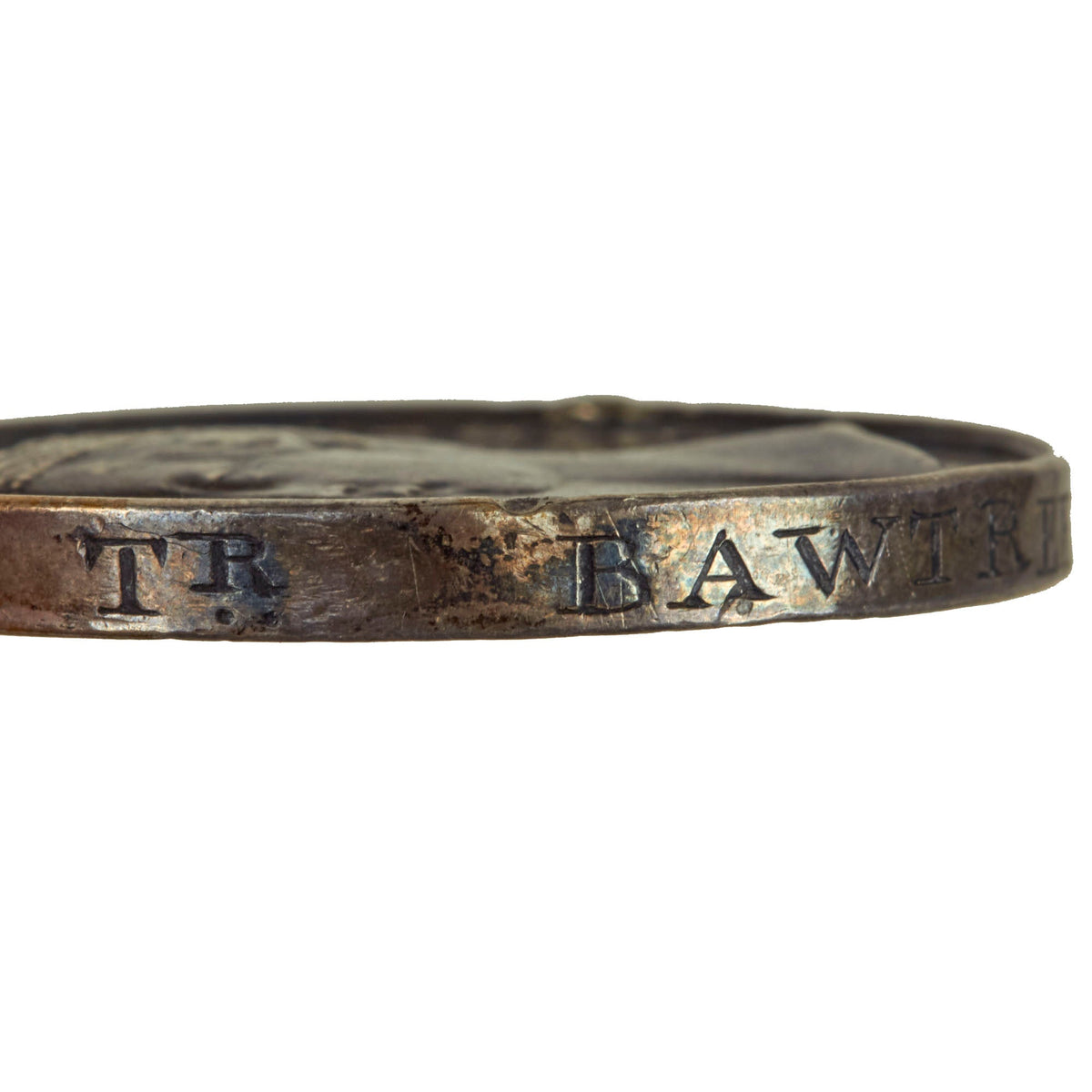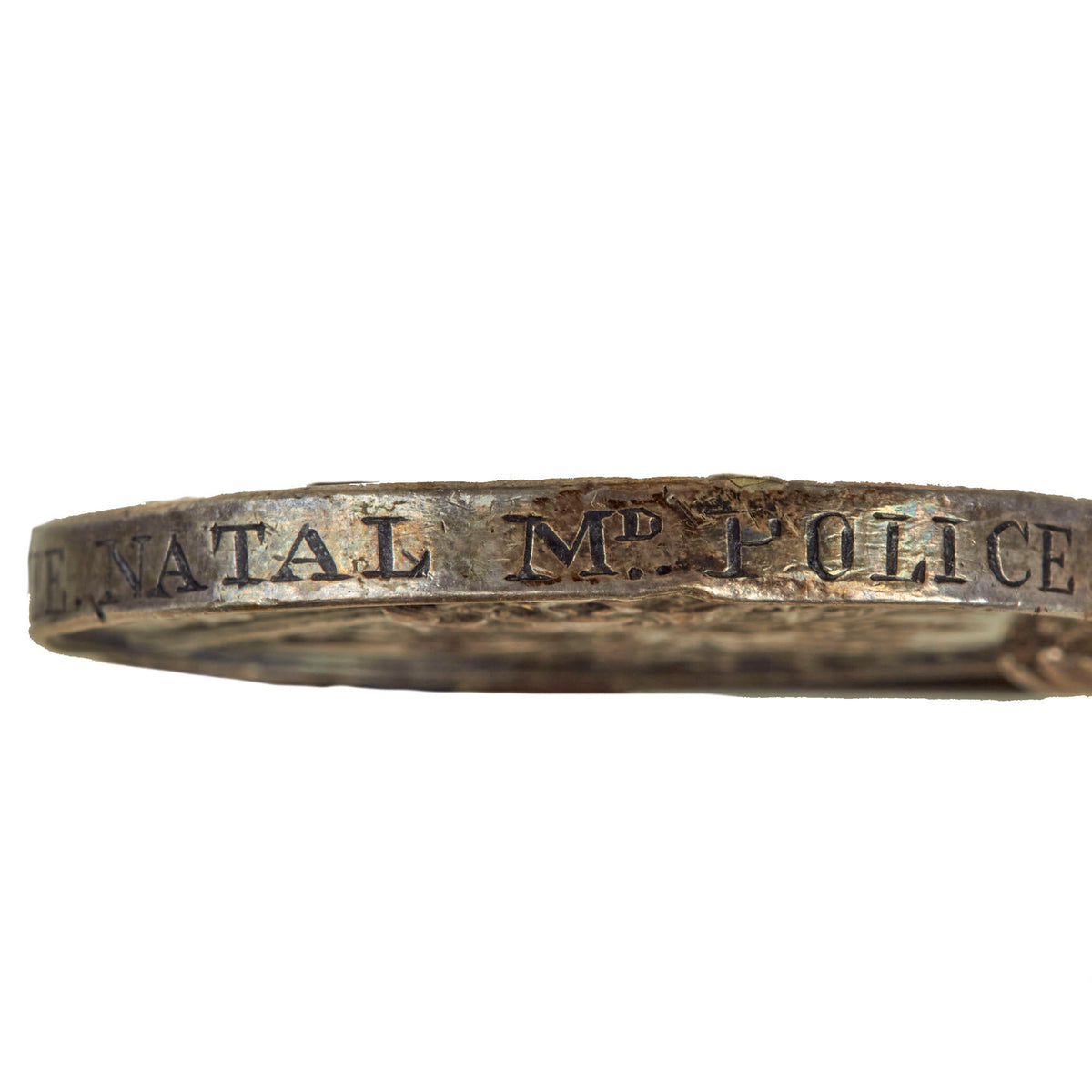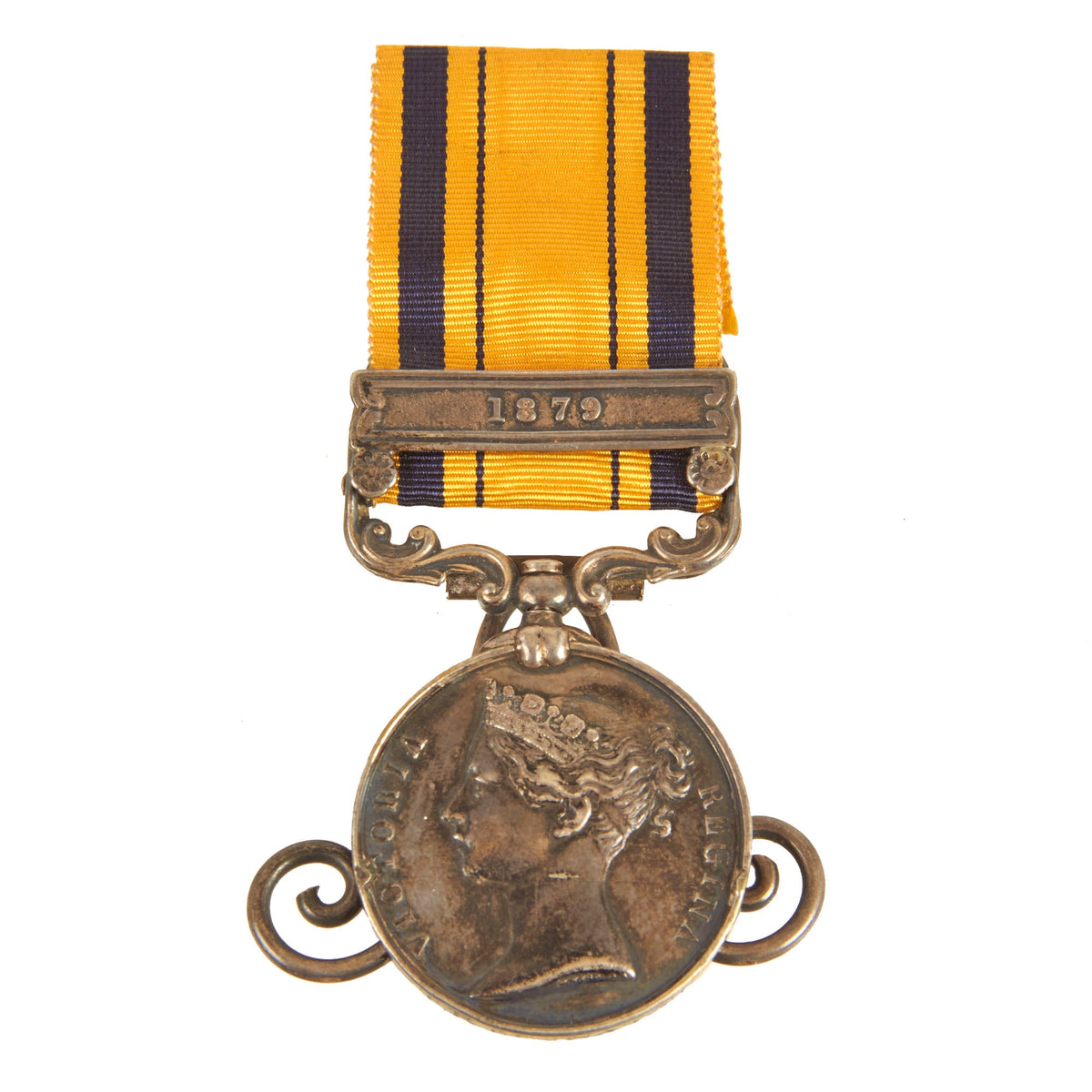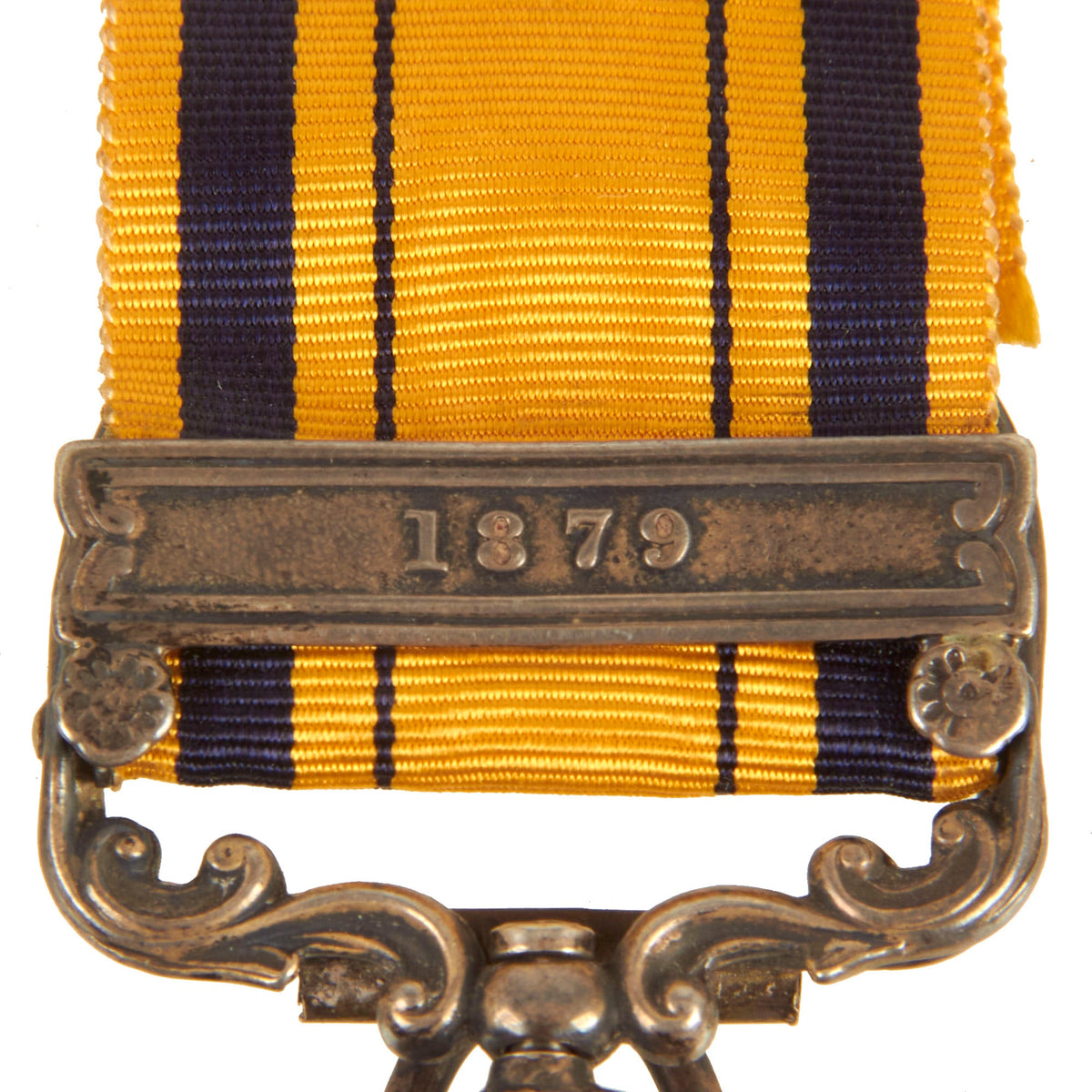Original British Anglo-Zulu War Rim Engraved South Africa Medal with 1879 Clasp Named to Trooper W.J.E. Bawtree, Natal Mounted Police Original Items
$ 2.495,00 $ 623,75
Original Item: One-Of-A-Kind. When it comes to rare campaign medals of the British Empire, this one makes it’s way towards the top, not for the medal itself but the Trooper who wore it. This South Africa Medal with a rare 1879 clasp, was presented to Trooper W.J.E. BAWTREE, a member of the Natal Mounted Police. If you are familiar with the Zulu Wars, then Natal should stand out to you. Natal was the location of one of the biggest underdog victories in history, the Battle of Rorke’s Drift. Just over 150 British and colonial troops defended the station against attacks by 3,000 to 4,000 Zulu warriors, Trooper Bawtree was present for this. While he was not one of the “Defenders of Rorke’s Drift”, the actions of his column in the pursuit of the Zulu attackers still made their way into the history books, being granted one of the few whose names will always be known.
Trooper Bawtree and the Natal Mounted Police during Battle of Isandlwana and Battle of Rorke’s Drift
The 120 strong troop of Natal Mounted police arrived at the fated British camp at Isandlwana around the 18th January 1879 under the command of Major John Dartnell, a former regular British army officer, W.J.E Bawtree was amongst them.
On the 20th January Dartnell received orders to carry out a “reconnaissance in force” in the Malakatha /Hlazakazi range of hills seven miles to the South West of the camp, including an area around the Mangeni gorge, which Chelsford had intended to provide the next staging camp for his planned move toward the Zulu capital of Ondini (Ulundi).
Intelligence gleaned earlier a captured elderly Zulu by one of the NMPs own officers, Sub Inspector Philips, pointed to a large impi in that area and Dartnell was despatched with 80 men and another of his junior officers Mansell, 20 men of the newcastle mounted rifles,a substantial force of 16 companies of Natal Native Contingent under Rupert Lonsdale to flush them out, The force left before Dawn on the 21st January.
The 21st of January proved a frustrating day, the force encountered large parties of Zulus, who chose to flee rather than fight, until late afternoon, when unexpectantly a large force of Zulu’s , about 1500 appeared, and forming their classic horns of the buffalo charged to engage Dartnell over the crest of Magogo, a large hill.
Dartnells force, now spread thinly, rose rapidly to reform, and the force moved to high ground, a small range called Hlazakzi for protection. There, with daylight fading they chose to encamp and formed two mutually supporting squares for protection. Here Dartnell wrote a note, stating his intention to Lord Chelmsford , commander of the British force at Isandlwana camp that he was to Bivouac there, pending reinforcements being sent up from the camp, noting that he had found the vanguard of the main zulu army….he was wrong.
Dartnell despatched a young Lieutenant, Henry Walsh, with an escort of about 20 men off in the fading light with 20 men with the note and they disappeared into the gloom, it was to be a long, frightening night.
As night fell, the hills around the bivouac lit up with Zulu camp fires, no sleep was to be had as the men expected a zulu assault any moment.
Miraculously, Walsh had succeeded in making his way to Isandlwana camp, and returned with a reply from Lord Chelmsford, a force indeed was to be sent out the next day, it was the 22nd January 1879. Despite the late hour Walsh was then dispatched into the Darkness, this time with an escort of only 3 men back to the main camp with a note to bring at least three regular companies of the 24th foot to engage the large force he had encountered.
Walsh arrived back in Isandlawana camp around 1am , he reined his horse at the force HQ and with that note Chelmsford too, took the bait the zulu’s had laid, There indeed in the was the main zulu army as Dartnell had predicted, he was to leave with half of his force, within a few hours, engage and destroy it. He left before dawn on Wednesday the 22nd, except Chelmsford chose a far superior force than Dartnell had proposed.
The proceeding battle of Isandlwana was to prove a disaster in British military history, the camp at Isandlwana was attacked by 25,000 Zulus, of the main zulu army, only 55 European troops were to survive of a force of 1400.
For Dartnell and his men, including Bawtree, the 22nd was a frustrating day, no Zulus were to be seen, Chelmford had arrived with 6 companies and 3 cannons only to spend the day looking for a Zulu impi that had vanished. By late afternoon reports had come back that the camp at Isandlwana had indeed been attacked and they must return.
It took some understanding, and disbelief, the camp destroyed? . Finally the weary force regrouped and made its way back in the fading light, approaching the now quiet camp only a few Zulu’s, drunken by the spirits found shouted out, had been utterly destroyed, in the distance through the blackness of the night Rorkes Drift burned.
Bawtree would have rested in the darkness amongst the 1500 eviscerated corpses now littering the camp, by first light Chelmsford had the force retire to Rorkes Drift to save the men the sights they would have seen.
As the force wandered back to Rorkes Drift, they passed a huge Zulu force, utterly spent slowly heading back to Zululand, a few insults were traded, but no shots fired. As Bawtree would have made his way up to the smoking ruins of the mission station he must have dreaded the future, but cheering could be heard…. the union flag still flew over the garrison.
Bawtree’s medal is a fantastic South Africa Medal of 1880, not to be confused with other Campaign Medals bearing a similar title. The best feature of this award is that Trooper Bawtree had a silver easel attached to the back of it. This simple yet elegant fixture made it possible for the medal to stand on its own, indicating that Bawtree was proud of his service and would often reflect upon it.
The South Africa Medal (1880), often referred to as the Zulu War Medal, is a campaign medal instituted in 1880 and awarded by the British Government to members of the British Army, Royal Naval Brigade and Colonial Volunteers who were involved in a series of South African tribal wars in the Cape of Good Hope, Colony of Natal and Transvaal between 1877 and 1879, most notably for the Anglo-Zulu War of 1879.
In 1854, Queen Victoria had given approval for the award of the South Africa Medal (1853) to members of the British Army who had served in any one of the three South African Xhosa Wars of 1834–36, 1846–47 and 1850–53 on the Eastern Frontier of the Cape of Good Hope.
Between 1877 and 1879 a number of particularly difficult punitive expeditions were mounted by the British against Xhosa, Zulu and Basuto tribes in the eastern area of the Cape of Good Hope and northern Natal, as well as against the Bapedi of Chief Sekhukhune in the northern Transvaal. In 1880 a medal was sanctioned for these campaigns, which was a new version of the South Africa Medal (1853) with minor alterations to the reverse design.
While Army Order no. 103 of August 1880, which instituted the new South Africa Medal (1880), made no mention of any change in design of the 1854 medal, the year “1853” in the older medal’s reverse exergue was replaced by a military trophy consisting of a Zulu ox-hide shield and four crossed assegais. The obverse of the new medal remained identical to that of the earlier medal.
The medal was struck in silver and is a disk, 36 millimeters in diameter, with a swiveling suspender. Designed by William Wyon and his son Leonard Charles Wyon, with the dies for the medal engraved by Leonard Charles Wyon.
Obverse
The medal’s obverse displays the diademed head of Queen Victoria, facing left. The medal is inscribed “VICTORIA” at left and “REGINA” at right around the perimeter. The name of designer W. Wyon is inscribed on the truncation of the Queen’s neck.
Reverse
The reverse shows a crouching lion on a plinth in front of a protea bush with a single flower. The medal is inscribed “SOUTH AFRICA” around the top perimeter and has a Zulu ox-hide shield and four crossed assegais in the exergue, replacing the year 1853. The name of engraver L.C. Wyon is inscribed at the bottom, below the year.
Naming
The name and regiment of the recipient is engraved on the rim. This one is the correct measurement at 35.41mm and Roman block letter style of the period for this medal. The rim on this shows no signs of any past molestation with this being the first inscription made. It reads as:
TR. BAWTREE. NATAL MD. POLICE.
Ribbon
The ribbon is 32 millimeters wide, with a 2 1⁄2 millimeters wide golden yellow band, a 4 millimeters wide dark blue band, a 3 millimeters wide golden yellow band and a ½ millimeter wide dark blue band, repeated in reverse order and separated by a 12 millimeters wide golden yellow band.
The overall condition in the medal collecting world would be considered good/fine and we wholeheartedly agree. The unique and personal touch by adding the hinged easel on the reverse is simply beautiful. The details are still prominent and not worn down like most encountered in todays market. There is minor age toning on the ribbon and tarnishing on the silvered portions but these factors only add to the beauty of the award.
No Zulu Wars collection is complete without a campaign medal to display alongside, especially one of this such caliber. It’s not very often you encounter a medal named to an individual who played a part in one of the most significant and famous battles in world history.
Carry on the legacy of Trooper Bawtree and his comrades. Comes more than ready for further research and display.
Fast Shipping with Professional Packaging
Thanks to our longstanding association with UPS FedEx DHL, and other major international carriers, we are able to provide a range of shipping options. Our warehouse staff is expertly trained and will wrap your products according to our exact and precise specifications. Prior to shipping, your goods will be thoroughly examined and securely secured. We ship to thousands clients each day across multiple countries. This shows how we're dedicated to be the largest retailer on the internet. Warehouses and distribution centres can be located throughout Europe as well as the USA.
Note: Orders with more than one item will be assigned a processing date depending on the item.
Before shipping before shipping, we'll conduct a thorough inspection of the items you have ordered. Today, the majority of orders will be delivered within 48 hours. The delivery time will be between 3-7 days.
Returns
The stock is dynamic and we cannot completely manage it because multiple stakeholders are involved, including our factory and warehouse. So the actual stock may alter at any time. It's possible that you may not receive your order once the order has been made.
Our policy is valid for a period of 30 days. If you don't receive the product within 30 days, we are not able to issue a refund or an exchange.
You can only return an item if it is unused and in the same state as the day you received it. You must have the item in its original packaging.
Related products
Uncategorized
Angolan Rebel 1970s era 60mm Inert Display Mortar from Angolan Civil War Original Items
Uncategorized
Uncategorized
Armoured Fighting Vehicles of the World: AFVs of World War One (Hardcover Book) New Made Items
Uncategorized
Uncategorized
Uncategorized
Uncategorized
Uncategorized
Uncategorized
Uncategorized
Uncategorized
Uncategorized
Uncategorized
Australian WWII Owen MK1 Machine Carbine SMG Custom Fabricated Replica with Sling Original Items
Uncategorized
Uncategorized
Uncategorized
Band of Brothers ORIGINAL GERMAN WWII Le. F.H. 18 10.5cm ARTILLERY PIECE Original Items
Uncategorized
Uncategorized
